18th Annual CHFR Symposium on Heart Research
The Center for Heart Failure Research (CHFR) was established in 2002 and has since then promoted the integration of high quality research from bench to bedside. Center members have a broad range of expertise; covering state-of-the-art gene technology, protein function, integrative physiology in pathophysiological models of heart failure and clinical studies. This collective knowledge and active research collaboration has resulted in more than 200 scientific publications each year.
Several members from Myocardial function and cardiac imaging research group and the collaborating researchers presented interesting results from their recent studies. Two PhD fellows were awarded with the best poster prize; Eystein Skjølsvik for his work on “Exercise is a marker of impaired left ventricular function in patients with Lamin A/C mutations” and Monica Chivulescu for her work on “High penetrance and similar disease progression in probands and family members with arrhythmogenic cardiomyopathy”.
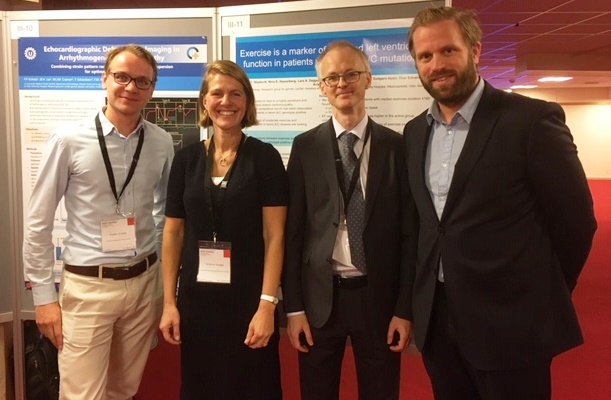
Photo: Oslo University Hospital (OUS)
Previous best poster prize winner in the session Diagnostic and therapeutical strategies for cardiac disease postdoctoral fellow Øyvind H. Lie, was among the speakeres at this year's Symposium. Lie talked about Cardiac arrest in sports: Knowledge and misconceptions. Øyvind H. Lie has also written about the subject in, among others, Indremedisineren and Aftenposten.
The first poster session “Biomarkers and cardiac disease”, moderated by Helge Røsjø and Erik Øie, took a deep dive in the predictive value of the highly sensitive cardiac troponin T marker.
Cardiac Troponin T and N-terminal pro-B-type natriuretic peptide for detection of Myocardial Ischemia among Patients with Suspected Stable Angina – a DOPPLER-CIP substudy
Authors: Myhre PL, Røsjo H, Sarvari SI, Ukkonen H, Rademakers F, Engvall JE, Hagve T-A, Nagel E, Sicari R, Zamorano JL, Monaghan M, D’hooge J, Edvardsen T, Omland T
Cardiac troponin T (cTnT) and N-terminal pro-B-type natriuretic peptide (NT-proBNP) have both been associated with myocardial ischemia, but it remains unclear whether this is directly caused by ischemia or if the elevation is indirect and related to myocardial dysfunction. Despite a significant association with ischemia, the diagnostic value of CtnT and NT-proBNP in stable coronary artery disease seems modest and comparable between the two. The study data suggest that the functional effects of myocardial ischemia may be a stronger stimulus for release of these biomarkers than ischemia per se.
High-sensitivity troponin T predicts mortality independently of ventricular dysfunction and pulmonary hypertension in stable chronic obstructive pulmonary disease
Authors: Kvisvik B, Skjørten I, Hilde JM, Strand H, Omland T, Steine K
Patients with stable chronic obstructive pulmonary disease (COPD) are at increasing risk of pulmonary hypertension and systolic dysfunction. Elevated hs-cTnT levels are associated with the severity of pulmonary hypertension and cardiac dysfunction in patients with stable COPD. Elevated levels remain associated with all-cause mortality after adjustment for pulmonary hypertension and indices of systolic dysfunction.
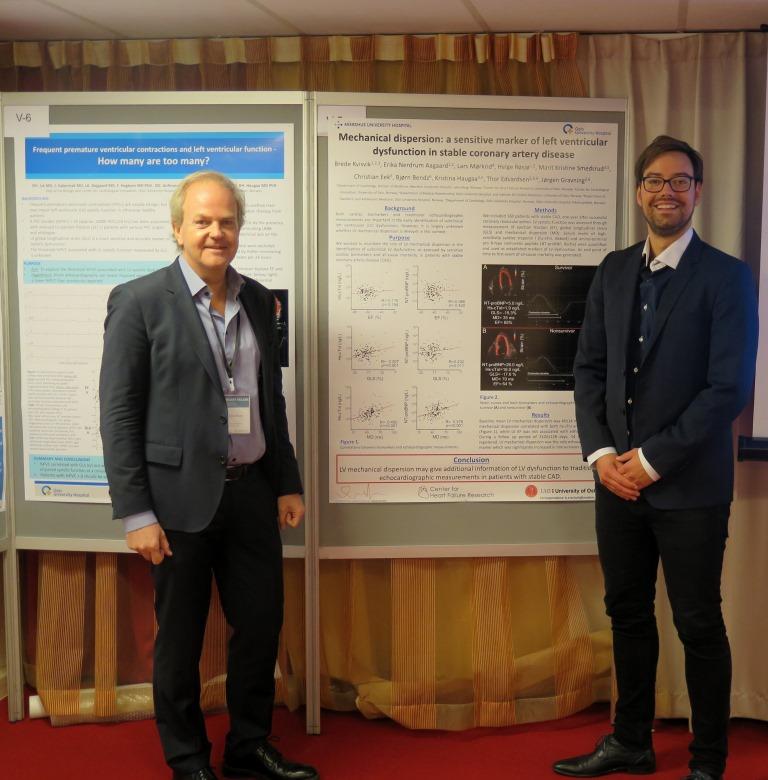
where he presented the poster
“Mechanical dispersion by strain echocardiography: a sensitive marker of left ventricular remodeling in stable coronary artery disease”
Authors: Kvisvik B, Aagaard EN, Mørkrid L, Rosjø H, Smedsrud MK, Eek C, Bendz B, Haugaa KH, Edvardsen T, Gravning J
Photo: Oslo University Hospital
Growth differentiation factor-15 predicts adverse outcome in stable chronic obstructive pulmonary disease patients independently of pulmonary hypertension
Authors: Sithiravel C, Kvisvik B, Lyngbakken M, Strand H, Skjørten I, Hilde JM, Steine K, Omland T
Growth differentiation factor-15 (GDF-15) is a stress responsive cytokine associated with mortality and acute exacerbations in chronic obstructive pulmonary disease (COPD). However, whether elevated GDF-15 levels are associated with mortality independently of pulmonary hypertension and cardiac dysfunction is not known. This study concluded that GDF-15 is an independent marker of all-cause mortality in COPD patients after adjustment of pulmonary hypertension.
The third session «Cardiac function during heart failure and exercise training», moderated by Øyvind Ellingsen and Ole-Jakob How, focused, as always, on the impact of exercise in heart failure.
Winning the best poster prize was Eystein Skjølsvik with his poster “Exercise is a marker of impaired left ventricular function in patients with Lamin A/C mutations”.
Authors: Skjølsvik ET, Hasselberg NE, Dejgaard LA, Lie ØH, Andersen K, Holm T, Edvardsen T, Haugaa KH
Competetive sports have been associated with adverse events in patients with lamin A/C mutations, but data on recreational exercise has been lacking. This study showed that systolic function was impaired in physically active lamin A/C patients, suggesting exercise restriction beyond competitive sports for this patient group.
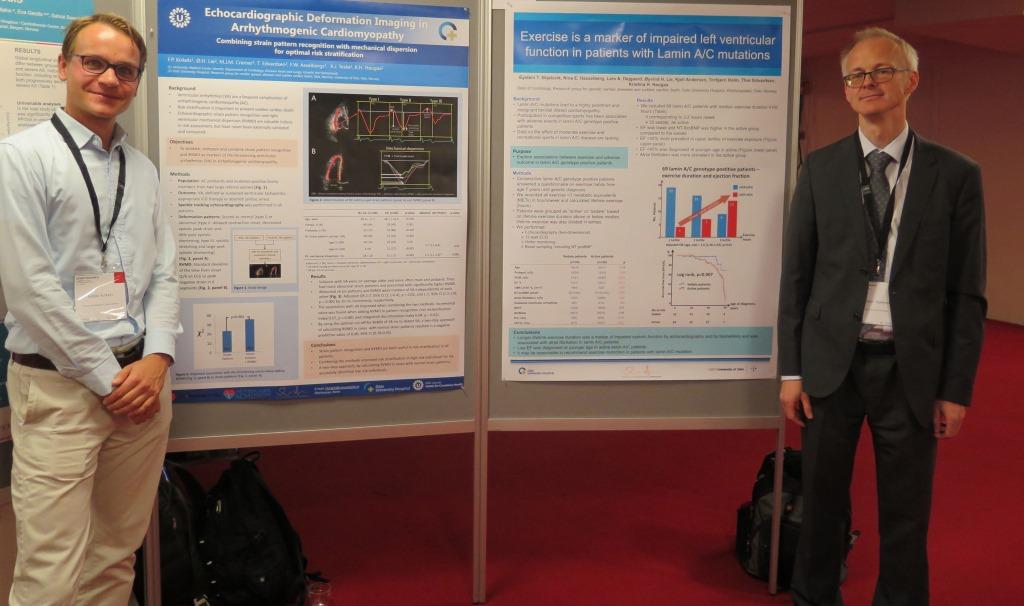
Photo: Oslo University Hospital
Echocardiographic deformation imaging in arrhythmogenic cardiomyopathy: Combining strain pattern recognition with mechanical dispersion for optimal risk stratification
Authors: Kirkels FP, Lie ØH, Cramer MJ, Edvardsen T, Asselbergs FW, Teske AJ, Haugaa KH
Echocardiographic strain pattern recognition and right ventricular mechanical dispersion (RVMD) are valuable indices in risk assessments of patients with arrhythmogenic cardiomyopathy (AC), but has never been externally validated and compared. Strain pattern recognition and RVMD are both useful in risk stratification in AC patients. Combining the methods improved risk stratification in high risk individuals for ventricular arrhythmias. Furthermore, a two-step approach, by calculating RVMD in cases with normal strain patterns, accurately identified low risk individuals.
Endurance exercise volume is not associated with the progression of coronary artery calcification; a longitudinal coronary computed tomography angiography study
Authors: Kleiven Ø, Bjørkavoll-Bergseth MF, Omland T, Aakre KM, Frøysa V, Erevik CB, Greve OJ, Melberg TH, Auestad B, Skadberg Ø, Edvardsen T, Ørn S
Recent cross-sectional studies have suggested a dose-dependent relationship between life-long exposure to physical activity and the burden of calcified coronary artery disease (CAD). The aim of this study was to assess the impact of exercise volume on the progression of CAD. The study concluded that no relationship between exercise volume and the progression of coronary artery calcification was found in this longitudinal study of middle-aged recreational athletes.
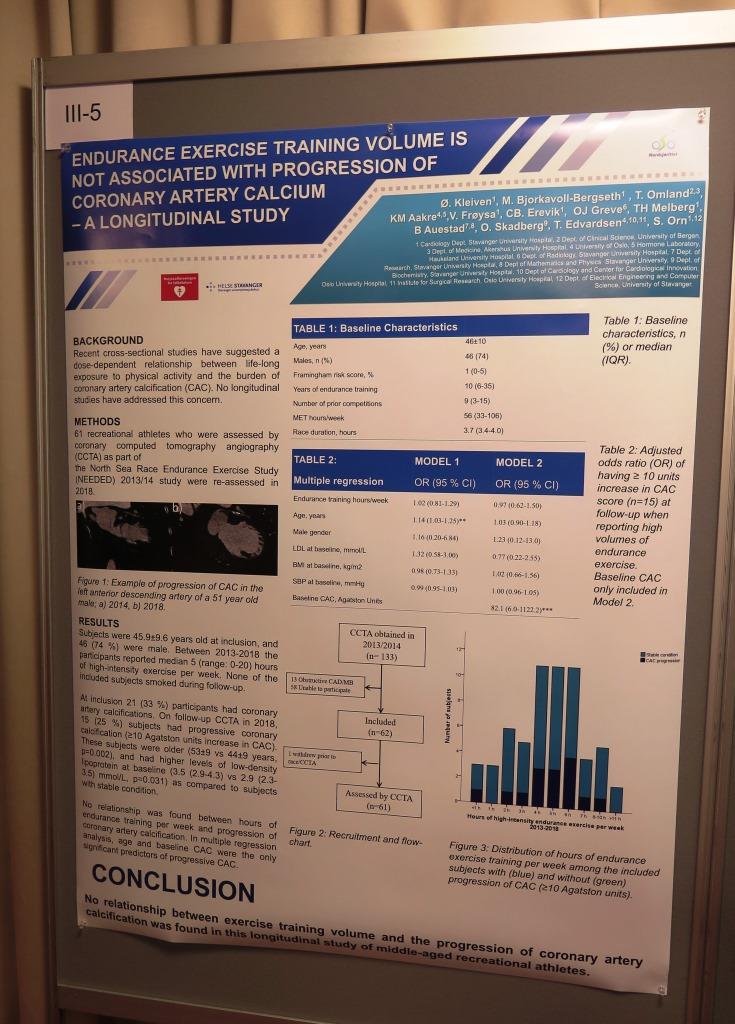
The fifth session «Diagnostic and therapeutical strategies for cardiac disease», moderated by Helge Midtbø and Geir Øystein Andersen focused on new diagnostic methods for improved patient care. Winning the best poster price was Monica Chivulescu with her poster “High penetrance and similar disease progression in probands and family members with arrhythmogenic cardiomyopathy”. Authors: Chivulescu M, Lie ØH, Popescu BA, Skulstad H, Edvardsen T, Jurcut RO, Haugaa K
The study concluded that disease penetrance was fairly high in family members both at inclusion and during follow-up. Rate of progression was similar in probands and family members with arrhythmogenic cardiomyopathy and structural progression was associated with higher incidence of severe arrhythmic event in arrhythmia free patients during follow-up.
This study was also mentioned in an ESC Cardio Talk during ESC Congress - the biggest cardiovascular event of the year, in addition to being featured in Dagens Medisin.
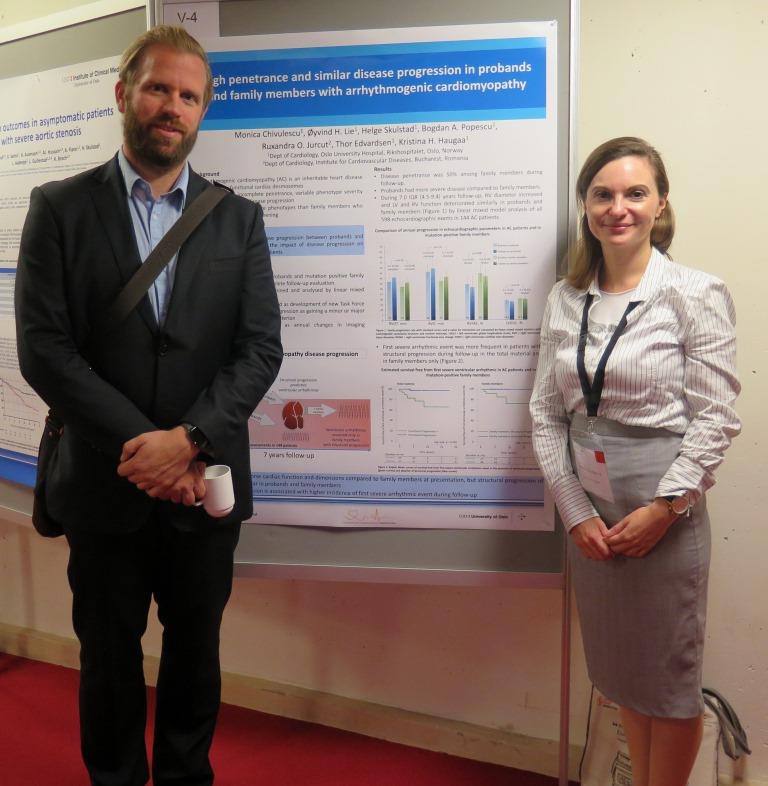
who was also speaking about cardiac arrest in sports during the symposium on the left.
Best poster price winner Monica Chivulescu on the right.
Photo: Oslo University Hospital (OUS)
MRI-based evaluation of regional hypertrophy in a mouse model of hypertrophic cardiomyopathy
Authors: Andreassen K, Rixon CL, Henriksen IM, Haugaa KH, Sjaastad I, Edvardsen T, Lunde IG, Stokke MK
Experimental mouse models of hypertrophic cardiomyopathy (HCM) provide important insight into HCM pathophysiology. The aim of this study was to develop an MRI-based protocol to determine regional hypertrophy in mice during disease progression. A customized software was developed to calculate maximum, minimum, and mean myocardial thickness, in addition to free wall and septum thickness, resulting in development of an MRI-based protocol for characterization of regional hypertrophy in a mouse model of HCM, which can be used for detection of HCM in mice.
This is a collaboration study with researchers from the Institute for Experimental Medical Research and the KG Jebsen Center for Cardiac Research.
